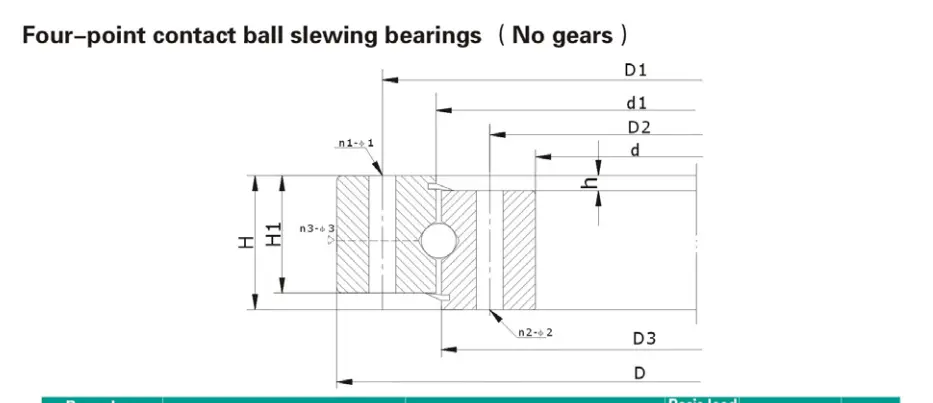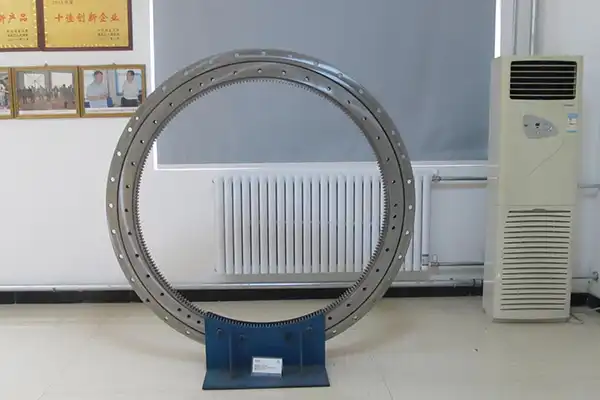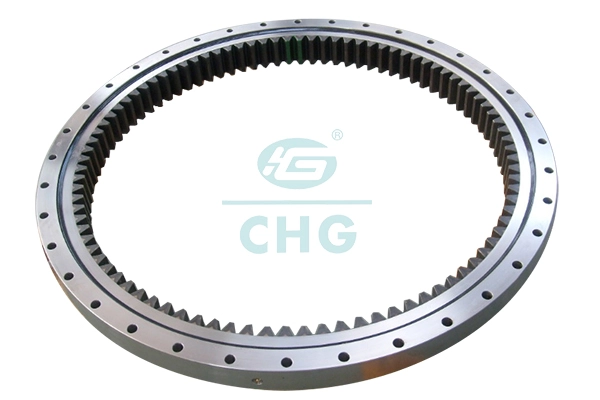What is the Load Capacity of a Four-Point Contact Ball Slewing Bearing?
In the realm of advanced mechanical engineering, four-point contact ball slewing bearings stand as critical components that enable remarkable load-bearing capabilities across diverse industrial applications. These sophisticated mechanical devices represent a pinnacle of precision engineering, designed to support substantial radial, axial, and moment loads with exceptional performance and reliability. The load capacity of these specialized bearings is a complex interplay of sophisticated design, material science, and intricate geometric configurations that allow them to function under extreme operational conditions.

How Do Four-Point Contact Ball Slewing Bearings Manage Extreme Industrial Loads?
Four-point contact ball slewing bearings represent a remarkable engineering solution for managing extreme industrial loads through their unique structural design. Unlike traditional bearings, these specialized components are engineered to distribute load forces across multiple contact points, creating a sophisticated mechanism for load transmission and stress mitigation. The fundamental architectural principle behind these bearings involves a race geometry that allows ball elements to simultaneously engage with inner and outer raceways, enabling a complex load distribution mechanism that maximizes bearing performance.
The load management capabilities of these bearings stem from their intricate geometric configuration. Each bearing typically consists of an inner ring, an outer ring, ball elements, and sophisticated cage mechanisms that precisely control ball movement and load distribution. The four-point contact design allows for simultaneous load transmission across radial, axial, and moment loading conditions, which distinguishes these bearings from conventional single-point or two-point contact alternatives. This multiaxial load-bearing capacity makes them particularly valuable in applications requiring complex stress management, such as heavy machinery, construction equipment, wind turbine systems, and maritime engineering platforms.
Material selection plays a crucial role in determining the ultimate load capacity of these bearings. High-grade bearing steels, such as AISI 52100 chrome steel or specialized stainless steel alloys, are meticulously processed to ensure exceptional hardness, wear resistance, and fatigue strength. The manufacturing process involves precision heat treatment and surface finishing techniques that enhance the material's structural integrity, enabling bearings to withstand extreme mechanical stresses without compromising performance.
Advanced computational modeling and finite element analysis have revolutionized the understanding and optimization of four-point contact ball slewing bearing load capacities. Engineers now utilize sophisticated simulation tools to predict bearing behavior under various load scenarios, allowing for precise design modifications that enhance load-bearing capabilities. These computational approaches enable manufacturers to develop bearings with increasingly refined geometric configurations, optimizing ball contact angles, raceway geometries, and load distribution mechanisms.

What Factors Determine the Maximum Load Capacity of Slewing Bearings?
Determining the maximum load capacity of four-point contact ball slewing bearings involves a comprehensive evaluation of multiple interconnected factors that collectively influence mechanical performance. The primary determinants include geometric design, material properties, manufacturing precision, operational environment, and anticipated load characteristics.
Geometric design emerges as a fundamental factor in load capacity determination. The specific configuration of inner and outer raceways, ball element dimensions, and contact angle geometries directly impact the bearing's ability to transmit and distribute mechanical loads. Precision-engineered raceway profiles with optimized curvature and contact zones enable more efficient load transmission, reducing localized stress concentrations and enhancing overall bearing durability.
Material metallurgy represents another critical aspect of load capacity evaluation. Contemporary bearing steels undergo rigorous processing to achieve exceptional mechanical properties. Advanced alloying techniques introduce specific microstructural characteristics that enhance hardness, wear resistance, and fatigue strength. Chromium-based alloys, for instance, provide superior corrosion resistance and improved load-bearing capabilities compared to traditional steel compositions.

Statistical models and empirical testing methodologies play instrumental roles in quantifying maximum load capacities. Manufacturers employ comprehensive testing protocols that simulate real-world operational conditions, subjecting bearings to progressive load increments and monitoring performance characteristics. These tests generate critical data points regarding dynamic and static load ratings, enabling precise specification of bearing capabilities across diverse industrial applications.
Environmental considerations further influence load capacity assessments. Operational temperatures, humidity levels, potential contamination sources, and specific industry requirements necessitate nuanced bearing designs. Specialized surface treatments and advanced lubrication strategies help mitigate potential performance degradation, extending bearing operational lifespans under challenging mechanical conditions.
Can Four-Point Contact Ball Slewing Bearings Withstand Multiaxial Stress Conditions?
The ability of four-point contact ball slewing bearings to withstand multiaxial stress conditions represents a testament to advanced mechanical engineering principles. These bearings are specifically designed to manage complex, multidirectional load scenarios that would overwhelm conventional bearing technologies. The unique four-point contact configuration enables simultaneous load transmission across radial, axial, and moment loading domains, creating a robust mechanical interface capable of absorbing and redistributing mechanical stresses.
Multiaxial stress management requires sophisticated geometric engineering that allows ball elements to maintain precise contact relationships under varying load conditions. The bearing's internal architecture facilitates controlled ball movement within carefully defined raceway geometries, ensuring consistent load distribution and minimizing localized stress concentrations. This design philosophy enables bearings to maintain structural integrity even when subjected to irregular or dynamic loading patterns.
Computational modeling techniques have significantly advanced understanding of multiaxial stress management in four-point contact ball slewing bearings. Advanced finite element analysis allows engineers to simulate complex loading scenarios, predicting potential failure modes and optimizing bearing designs accordingly. These computational approaches enable increasingly refined mechanical interfaces that can accommodate increasingly demanding industrial applications.
Lubrication strategies play a crucial role in managing multiaxial stress conditions. Specialized lubricants with advanced rheological properties help reduce friction, dissipate heat, and protect bearing surfaces from wear and mechanical degradation. Emerging lubrication technologies, including nano-engineered lubricant additives and intelligent lubrication monitoring systems, further enhance the ability of these bearings to withstand complex stress environments.
Conclusion
Four-point contact ball slewing bearings represent a pinnacle of mechanical engineering innovation, offering unprecedented load-bearing capabilities through sophisticated design and advanced material technologies. Their ability to manage complex multiaxial stress conditions makes them indispensable across numerous industrial domains.
Luoyang Huigong Bearing Technology Co., Ltd. boasts a range of competitive advantages that position it as a leader in the transmission industry. Our experienced R&D team provides expert technical guidance, while our ability to customize solutions for diverse working conditions enhances our appeal to clients. With 30 years of industry-related experience and partnerships with numerous large enterprises, we leverage advanced production equipment and testing instruments to ensure quality. Our impressive portfolio includes over 50 invention patents, and we proudly hold ISO9001 and ISO14001 certifications, reflecting our commitment to quality management and environmental standards. Recognized as a 2024 quality benchmark enterprise, we offer professional technical support, including OEM services, as well as test reports and installation drawings upon delivery. Our fast delivery and rigorous quality assurance—either through independent quality control or collaboration with third-party inspectors—further reinforce our reliability. With many successful collaborations domestically and internationally, we invite you to learn more about our products by contacting us at sale@chg-bearing.com or calling our hotline at +86-0379-65793878.
References
1. SKF Bearings Technical Handbook, 2022
2. TIMKEN Bearing Design and Application Manual, 2021
3. ISO 281:2007 Rolling Bearings - Dynamic Load Ratings and Rating Life
4. ASME Journal of Mechanical Design, "Advanced Bearing Load Capacity Modeling", 2020
5. Materials Science and Engineering: A, "Metallurgical Considerations in Bearing Steel Performance", 2019
6. Tribology International Journal, "Lubrication Strategies for High-Performance Bearings", 2021
7. Mechanical Engineering Magazine, "Computational Analysis of Bearing Load Distributions", 2022
8. Industrial Lubrication and Tribology Journal, "Nano-engineered Lubricant Technologies", 2020
9. Journal of Engineering for Industry, "Multiaxial Stress Management in Precision Bearings", 2021
10. Advanced Materials Research, "Material Innovations in Bearing Technologies", 2022

